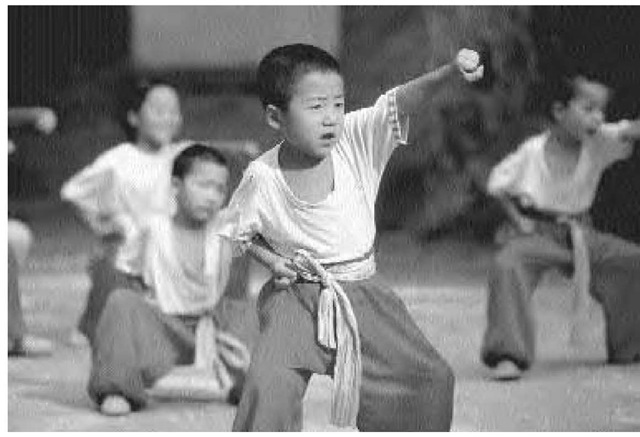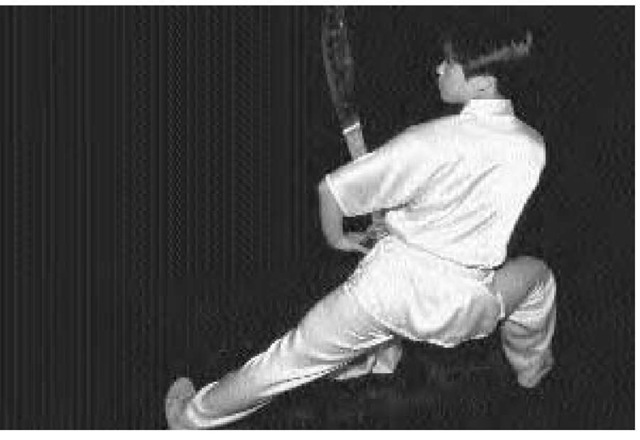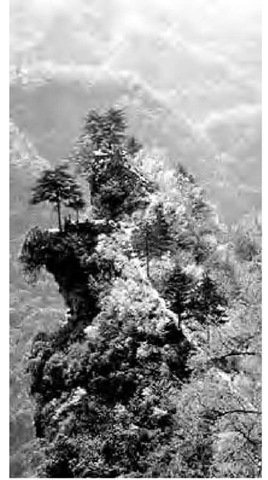Chinese boxing is a versatile form of bare-handed fighting, variously combining strikes with the hands, kicks and other leg maneuvers, grappling, holds, and throws. Piecing together the scattered passages in ancient writings, one can reasonably conclude that the origins of Chinese boxing go back as far as the Xia dynasty (twenty-first to sixteenth centuries b.c.), making it one of the oldest elements of Chinese culture still practiced.
Originally called bo (striking), it was a skill practiced among China’s early ruling classes, when strength and bravery were characteristics admired in leaders. There are even references to some of these leaders grappling with wild beasts. There are also descriptions of individuals skilled in empty-handed techniques against edged weapons. Thus, boxing appears generally to have been considered a life-and-death combat skill that supplemented weapons, although there are indications that it was treated as a sport in some circumstances.
However, about 209 b.c., the first emperor of Qin designated wrestling as the official ceremonial military sport. Then, for the first time, commentaries in the Han History Bibliographies (ca. a.d. 90) clearly distinguish between boxing and wrestling. This work lists six chapters (no longer extant) on boxing, shoubo (hand striking) as it was then called. Boxing is described under the subcategory “military skills,” alongside archery, fencing, and even a form of football, for “practice in using the hands and feet, facilitating the use of weapons, and organizing to ensure victory in both attack and defense” (Gu 1987, 205). So by the Warring States period (475-221 b.c.), boxing had become a basic military skill to develop strength and agility for use of weapons in hand-to-hand combat by the mass infantry forces of that time.
After the Southern Song capital was established at Hangzhou in 1135, the modern term quan (fist) appears and replaces shoubo as the common term for boxing. This seemingly abrupt change may have been based on common usage in the dialect spoken in the new capital. Some support for this view can be found in a later work by Zhu Guozhen (ca. 1621), who notes that boxing was more commonly known as daquan in his day (the term introduced during the Song period and still used today), but was called dashou (hitting hands) around Suzhou.
One contemporary Song author describes shiquan (employing the fists) as different from wrestling but similar to the skills used in the military. He thus infers that there was a popular form of boxing, similar to but not quite the same as that practiced in the military. This statement was probably based on the fact that military boxing was limited to practical, no-frills techniques employed in military formations, primarily to supplement the use of weapons, while the popular forms were likely to have been more individualistic and performance oriented, in the manner Ming general Qi Jiguang (1528-1587) condemned as “flowery.”
During the short, oppressive Mongol rule (1206-1368) that followed the Song, Chinese (called Hanren) were prohibited from practicing martial arts, but opera scores from the period reveal that boxing was included in military scenes of the operatic repertoire. This dramatic use of boxing undoubtedly encouraged the “flowery” phenomenon General Qi noted.
The Ming period (1368-1644) opens the first window in China’s long history through which to get an illustrated glimpse of Chinese boxing. The Ming experienced a chronic rash of large-scale Japanese and indigenous marauding and piracy in the southern coastal provinces during the mid-sixteenth century—an environment conducive to the application of traditional military martial arts. The ultimate solution came in the form of a well-led, disciplined volunteer peasant force trained in hand-to-hand combat by General Qi Jiguang and others. The existence of such a force in turn demanded a bottom-up training program supported by standardized, illustrated, easy-to-understand manuals that set an example and contributed greatly to what we now know about the martial arts in general and boxing in particular. General Qi Jiguang’s “Boxing Classic,” a chapter in his New topic of Effective Discipline (ca. 1561), not only provides illustrations of the thirty-two forms Qi selected from the most well-known styles of the day, but also records the names of sixteen of these styles for posterity. Prior to Ming times, boxing had only been mentioned in generic terms. Writings by several other Ming-period authors further raise the number of known styles to about thirty-six. These writings also offer insights into boxing techniques such as changquan (long fist) and duanda (short hitting), and they reveal a number of related boxing skills, including pofa (breaking), jiefa (escaping), nafa (seizing), and diefa (falling), some of which could be categorized as independent fighting systems, which show a striking similarity to Japanese jujutsu.
Chinese children in a martial arts class in Beijing, November 1997.
According to the Ming History (Zhang 1936), boxing was even included in the official military examinations toward the end of the Wanli era (1573-1620), possibly in recognition of General Qi Jiguang’s successes. Qi realized that boxing, in itself, was not particularly useful in battle, but that it was a confidence builder and provided the necessary foundation for effective use of the traditional weapons with which most of his troops were armed.
During this same period, some monks from Shaolin Monastery volunteered individually and in groups to help fight pirates. They were known to have practiced boxing, but no specific style of boxing was named for the monastery. Their main claim to fame lay in their skill with iron staves, and on one occasion their heroic exploits earned them the everlasting reputation of Shaolin Monk Soldiers.
A martial artist in Beijing practices Chinese boxing, one of the oldest elements of Chinese culture still practiced.
With the Manchu conquest of China in 1644, Chinese boxing became politicized, perhaps to a greater degree than it had ever been before. Among his writings, the pro-Ming historian, Huang Zongxi, included comments on an epitaph dated 1669 (1936, 5a-6b) that appear to have been misinterpreted ever since. In the context of the times, his description of an External School of boxing originating in Buddhist (foreign religion) Shaolin Monastery meeting its match in an Internal School originating on Daoist (indigenous religion) Mount Wudang can be seen as symbolizing Chinese opposition to the Manchus. However, less critical individuals took this piece literally as a serious discourse on Chinese boxing theory, an interpretation that has encouraged a degree of divisiveness in the Chinese martial arts community to this day.
Other anti-Manchu intellectuals and teachers such as Yan Yuan (1635-1704) practiced boxing and other martial arts as part of what they considered to be a well-rounded education. Heterodox religious groups such as the Eight Trigrams and White Lotus sects used martial arts for self-defense and included them in their religious practices. The Heaven and Earth Society, otherwise known as the Triads or Hong League, practiced martial arts, including Hongquan (Hong Boxing), and attempted to identify their organization with the fame of Shaolin Monastery. Professional martial artists ran protection agencies and escort bureaus to protect commercial enterprises and the homes of the wealthy, and to ensure the safe transport of valuable items. Finally, there were various protest groups such as the Boxers United in Righteousness, whose antiforeign movement in 1900 brought the retaliation of an eight-nation expeditionary force comprising British, French, Italian, Russian, German, Japanese, Austro-Hungarian, and American troops.
A modern picture of a Buddhist monastery on Mount Wudang.
The boxer’s fists and talismans proved no match for bullets as China entered the twentieth century. Under the Manchu Qing dynasty they were a symbol of China’s backwardness, but after the Revolution of 1911, the traditional martial arts became a symbol of nationalism when they were introduced into the public school system as a uniquely Chinese form of physical fitness.
One survey conducted in 1919 identified 110 different boxing styles being practiced throughout the country (73 in the Yellow River region of north China, 30 in the Yangze River region, and 7 in the Pearl River area). Many professional martial artists opened their own guoshuguan (training schools), and some became associated with a government-sponsored Central Martial Arts Institute that was established in the Nationalist capital of Nanjing in 1927. The institute was originally organized into Wudang (internal—including only taijiquan, baguazhang, and xingyiquan) and Shaolin (external—comprising all other styles) branches according to the Chinese view of their two major boxing schools. Using boxing as its foundation, the institute produced martial arts instructors for public service. Prior to the anti-Japanese War of Resistance (1937-1945), nationwide form and contact competitions were held, with mixed results.
The Nationalists abandoned the program when they retreated to Taiwan in 1949, but the Communists built upon its foundation. Under the Physical Culture and Sports Commission, they integrated traditional martial arts into their physical education programs and developed standardized routines of changquan (long boxing), nanquan (southern boxing), taiji-quan, and weapons routines for nationwide practice and competition.
During the Great Proletarian Cultural Revolution (1966-1976), aspects of the traditional martial arts, such as teacher-disciple relationships, were severely criticized, and many old, valuable documents were destroyed in what could be termed a decade of blind ignorance. Since the Cultural Revolution, especially after 1979, there has been a revival of the program, although interest in state-sponsored activities has dwindled.
Meanwhile, there has been recognition of the fact that the earlier emphasis on standardized routines has resulted in neglect and loss of some aspects of the traditional arts, particularly in the practical application of fighting techniques. But Chinese boxing and the martial arts in general have already begun to take on a new life outside China.
The world is beginning to realize that the term kung fu or gongfu really means “skill” in Chinese, not “boxing,” and that Chinese boxing has a long and colorful history, deeply rooted in Chinese society and culture for many centuries before the founding of Shaolin Monastery (ca. a.d. 425).



